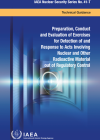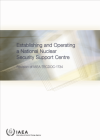The legal foundation for nuclear security consists of international instruments and recognized principles designed to control nuclear material and other radioactive substances. This broad range of instruments, many of which were developed under IAEA auspices, provides a framework for using such material in ways that protect all States.
Security
Responsibility for nuclear security rests entirely with each State. However, a number of States have not adhered to relevant instruments or implemented them effectively through their national legal and regulatory frameworks. This situation leaves gaps in the global system that can be exploited by terrorist or criminal elements.
The universal adherence to relevant instruments, harmonization of national legal and regulatory frameworks, and effective application of relevant measures can make a major contribution towards combating nuclear terrorism. The IAEA seeks to inform and advise States about the relevant international legal instruments, and encourages adherence to and implementation of them.
There is no single international instrument that addresses nuclear security in a comprehensive manner. The international regulatory framework for nuclear security relies mainly on the Convention on Physical Protection of Nuclear Material (CPPNM) and its Amendment; the Code of Conduct on the Safety and Security of Radioactive Sources (Code of Conduct) and its Guidance on the Import and Export of Radioactive Sources; the Safeguards Agreements and their Additional Protocols; the Nuclear Terrorism Convention; and the United Nations Security Council resolutions 1540 and 1373.
The CPPNM and its Amendment are the legally binding international instruments in the area of physical protection of nuclear material. They establish measures related to the prevention, detection and punishment of offenses related to nuclear material in international transport.
In the Code of Conduct on the Safety and Security of Radioactive Sources and its Guidance on the Import and Export of Radioactive Sources, States commit themselves to reinforcing the safety and security of radioactive sources by establishing effective controls, and to protect against, and ensure the timely detection of, the theft, loss or unauthorized use or removal of radioactive sources.
The requirements for accounting and control of nuclear material and for the establishment of the related systems contained in Safeguards Agreements and their Additional Protocols is a major component in the international nuclear security infrastructure. The objective of safeguards is the timely detection of diversion of significant quantities of nuclear material from peaceful nuclear activities to the manufacture of nuclear weapons or of other nuclear explosive devices or for purposes unknown, and deterrence of such diversion by the risk of early detection. With regard to nuclear security, the objectives of the State's physical protection system should be to establish conditions which would minimize the possibilities for unauthorized removal of nuclear material and/or for sabotage
The International Convention for the Suppression of Acts of Nuclear Terrorism was opened for signature on 14 September 2005. It details offences relating to the unlawful and intentional possession and use of radioactive material or a radioactive device, and use or damage of nuclear facilities. The Convention entered into force in July 2007.
The United Nations Security Council resolutions 1373 (2001) and 1540 (2004) address, among other things, the threat of nuclear terrorism and nuclear proliferation and call for national, regional and international cooperation to strengthen the global response to these challenges and threats to international security.







